

Fact-checking Donald Trump's talking points about the economy. President Donald Trump campaigned hard on a promise to kick the economy into high gear and with the latest economic numbers, he had something to crow about.

The economy grew at an annualized rate of 4.1 percent between April and June. Trump said the country was seeing proof of the power of his tax- and regulation-cutting agenda. Let’s take a look at some of his assertions and see whether they hold up. "In the second quarter of this year, the United States economy grew at the amazing rate of 4.1 percent. " Trump is correct about the 4.1 percent growth rate for gross domestic product in the second quarter of 2018. This is a strong showing in the context of recent history, and the highest since the third quarter of 2014. Quarterly increases of at least 4 percent are not unheard of. White House remarks – Friday, July 27, 2018. Information & Media Literacy. Alternative Truth. News Literacy. PT 3OnlineToolsSniffFakeNews. Evaluating Sources in a ‘Post-Truth’ World. Back in 2015, when we published our lesson plan Fake News vs.
Real News: Determining the Reliability of Sources, we had no way of knowing that, a year later, the Oxford Dictionaries would declare “post-truth” the 2016 word of the year; that fake news would play a role in the 2016 presidential election; that it would cause real violence; and that the president-elect of the United States would use the term to condemn mainstream media outlets he opposes. Back then, to convince teachers that the skill was important, we quoted Peter Adams of the News Literacy Project on the “digital naïveté” of the “digital natives” we teach. Now, however, we doubt that we need to convince anyone. These days, invented stories created in a “fake news factory”— or by a 23-year-old in need of cash — go viral, while articles from traditional sources like The Times are called “fake news” by those who see them as hostile to their agenda.
As always, we welcome your ideas; please post them in the comments. Mr. Is Mr. The Problem (and how our students can solve it) 5 Laws of Media & Info Literacy. Can your students tell fact from fiction? Can You Tell Fake News From Real? Study Finds Students Have 'Dismaying' Inability.
Stanford researchers assessed students from middle school to college and found they struggled to distinguish ads from articles, neutral sources from biased ones and fake accounts from real ones.
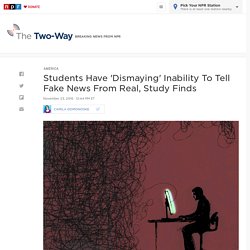
Gary Waters/Ikon Images/Getty Images hide caption toggle caption Gary Waters/Ikon Images/Getty Images Stanford researchers assessed students from middle school to college and found they struggled to distinguish ads from articles, neutral sources from biased ones and fake accounts from real ones. If the children are the future, the future might be very ill-informed. That's one implication of a new study from Stanford researchers that evaluated students' ability to assess information sources and described the results as "dismaying," "bleak" and "[a] threat to democracy. " As content creators and social media platforms grapple with the fake news crisis, the study highlights the other side of the equation: What it looks like when readers are duped.
"The photograph had no attribution. Free Online Course on Identifying Misinformation. Is that photo of a shark swimming down a highway in Texas real?
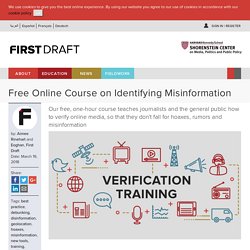
Is that story published on what looks like the website of a national broadcaster all as it seems? Is that Twitter account being quoted across the mass media legitimate – or is it a bot, troll or imposter? In the past three years, we’ve trained thousands of journalists to answer such questions – and many more. Similar skills and techniques allowed the Washington Post to scrutinize digital footprints and avoid falling victim to a hoax about Alabama Senate candidate Roy Moore in November. They are the same that enabled Storyful to alert its media clients worldwide that the wrong person was being publicly blamed for a mass shooting. Today, we’re releasing our short course on essential verification skills to train even more journalists, teachers and others dealing with online information on how to authenticate what they see online.
The godfather of fake news. Information Literacy Lessons. Information Literacy Classroom. Lessons from the NY Times. Fake News! Resources for Media Literacy. Fake News & Media Literacy. Fake News and Website Evaluation. COLLECTION: Media Literacy and Fake News.
How to Think Critically. Fake News. News and Media Literacy Collection. Tips and Resources - Fake News Guide - Mount A Libraries at Mount Allison University Libraries & Archives. Fake News: How to Spot It. The topic of fake news is as old as the news industry itself—misinformation, hoaxes, propaganda, and satire have long been in existence.

This guide will help you determine the kinds of fake news that exist and provide tools for how to evaluate news for its reliability and truth. Sources of News A variety of sources for news exist, and the most widely used are listed below. RadioThere are many types of radio broadcasters, including commercial and noncommercial, that deliver news to listeners. It is common for local radio stations to exist as affiliates of larger broadcast networks.
Newspapers The highest circulating print newspapers in the United States include USA Today, The Wall Street Journal, The New York Times, and The Washington Post. Television The largest broadcast US television news networks include NBC, CBS, ABC, and Fox. Battling Fake News in the Classroom. In this post-election period, there has been a lot of discussion about fake news, particularly about how it is spread and shared online, and whether it influenced the recent presidential election. On November 22, Stanford University released an influential study showing that middle and high school students—and even some in college—have trouble distinguishing which online resources are credible. The inescapable fact is that young people need to be prepared for the Wild West of information that they live in and will grow up in.
It is also imperative that we, as educators, prepare young people for the important job of responsible and informed citizenship. EdWebet74. Fake news and the spread of misinformation. It’s too soon to say whether Google’s and Facebook’s attempts to clamp down on fake news will have a significant impact.
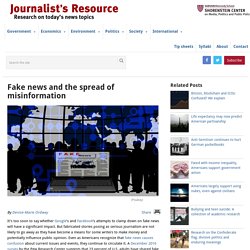
But fabricated stories posing as serious journalism are not likely to go away as they have become a means for some writers to make money and potentially influence public opinion. Even as Americans recognize that fake news causes confusion about current issues and events, they continue to circulate it. A December 2016 survey by the Pew Research Center suggests that 23 percent of U.S. adults have shared fake news, knowingly or unknowingly, with friends and others.
“Fake news” is a term that can mean different things, depending on the context. KS2 What Is Fake News? Resource Pack - fake news, scam, fake. 10 Resources to Teach Your Students How to Spot Fake News – American TESOL Institute. Govtsearches.com. Sos.wa.gov/q/Fake-News Jun 1, 2017 ...

Research. Teaching Strategies to Detect Fake News. During his farewell address in Chicago, President Obama stated, “Increasingly we become so secure in our bubbles that we start accepting only information, whether it’s true or not, that fits our opinions, instead of basing our opinions on the evidence that is out there.”

He wasn’t just speaking about social media echo chambers and fervent emotional appeals. He was speaking about fake news. Fake news is news that is explicitly made up. A lie. False information passed off as though true. The advent of smartphones and tablets allows students more access to information than any generation of humanity ever before. Thankfully, teachers have responded to the fake news epidemic in droves. UnSpun: Finding Facts in a World of Disinformation by Brooks Jackson and Kathleen Hall Jamieson tops my list of must-reads for teachers. Resources - Fake News - Research & Subject Guides at Stony Brook University. Resources for Teaching About Fake News & News Literacy - Institute for Humane Education. By Marsha Rakestraw In his recent book, Weaponized Lies: How to Think Critically in the Post-Truth Era, Dr.

Daniel Levinson emphasizes the importance of everyone bringing “careful thinking” to information verification and taking the time to consider the validity of information, especially before we share it. Resources for Instructors - Busting Fake News: Evaluating Online Information - Research Guides at University of Delaware. How to Convince Someone When Facts Fail. Have you ever noticed that when you present people with facts that are contrary to their deepest held beliefs they always change their minds?
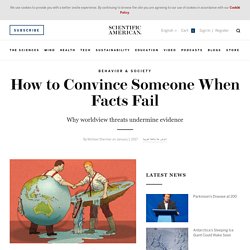
Me neither. In fact, people seem to double down on their beliefs in the teeth of overwhelming evidence against them. The reason is related to the worldview perceived to be under threat by the conflicting data. Creationists, for example, dispute the evidence for evolution in fossils and DNA because they are concerned about secular forces encroaching on religious faith. Anti-vaxxers distrust big pharma and think that money corrupts medicine, which leads them to believe that vaccines cause autism despite the inconvenient truth that the one and only study claiming such a link was retracted and its lead author accused of fraud. In these examples, proponents' deepest held worldviews were perceived to be threatened by skeptics, making facts the enemy to be slayed.
Fake news lesson plan. Fake News Isn't New: Researching Its History with NYPL's E-Resources. The term "fake news" may be receiving a lot of attention lately, but it is by no means new or unique to this day and age.
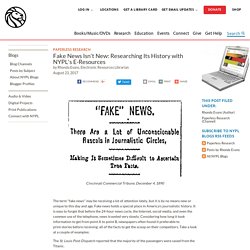
Fake news holds a special place in America's journalistic history. It is easy to forget that before the 24-hour news cycle, the Internet, social media, and even the common use of the telephone, news traveled very slowly. Considering how long it took information to get from point A to point B, newspapers often found it preferable to print stories before receiving all of the facts to get the scoop on their competitors. Take a look at a couple of examples: The St. Or when The New York Herald mistakenly wrote that the Union Army won the first Battle of Bull Run. Fake News Lessons. Bhhslibrary. Evaluating Sources in a ‘Post-Truth’ World: Ideas for Teaching and Learning About Fake News.
PBS NewsHour Extra. Lesson plan: How to teach your students about fake news. Fake news is making news, and it’s a problem. Not only did a BuzzFeed data analysis find that viral stories falsely claiming that the Pope endorsed Donald Trump and that Hillary Clinton sold weapons to terrorists receive more Facebook attention than the most popular news stories from established news outlets, but a false story about child trafficking in a Washington, D.C. pizza restaurant inspired a North Carolina man to drive 5 hours with a shotgun and other weapons to investigate. This lesson gives students media literacy skills they need to navigate the media, including how to spot fake news. Subjects Social studies, U.S. government, civics, journalism Estimated Time.
Fake News Resources for Teachers - Julie Smith. Fake news. Check your sources. How To Tell Fake News From Real News In 'Post-Truth' Era. Behind the fake news crisis lies what's perhaps a larger problem: Many Americans doubt what governments or authorities tell them, and also dismiss real news from traditional sources. But we've got tips to sharpen our skepticism.
Turnbull/Getty Images/Ikon Images hide caption. What does post-truth mean for a philosopher? Image copyright NCH. Six questions that will tell you what media to trust - American Press Institute. Published Updated 10/23/13 11:37 am Tom Rosenstiel The executive director of the American Press Institute is an author, journalist, and media researcher. How Data And Information Literacy Could End Fake News. How Academia, Google Scholar And Predatory Publishers Help Feed Academic Fake News. The Fact Checker’s guide for detecting fake news. Consider these points before sharing a news article on Facebook. How To Tell Fake News From Real News In 'Post-Truth' Era. Can You Tell Fake News From Real? Study Finds Students Have 'Dismaying' Inability. Fact-Checking Won’t Save Us From Fake News.
Fake news. We’ve used this phrase so many times in the past two months that it’s almost lost meaning — partly because it can mean so many different things. American Libraries Magazine. Librarians—whether public, school, academic, or special—all seek to ensure that patrons who ask for help get accurate information. Given the care that librarians bring to this task, the recent explosion in unverified, unsourced, and sometimes completely untrue news has been discouraging, to say the least. According to the Pew Research Center, a majority of US adults are getting their news in real time from their social media feeds.